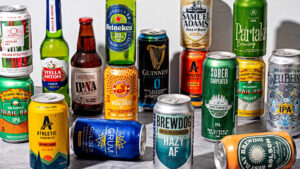The Rise of Non-Alcoholic Beer: A Trend Worth Following
In a groundbreaking shift that’s redefining the beverage industry, non-alcoholic beer is poised to eclipse ale as the second-largest beer category by volume worldwide in 2024, according to IWSR, the leading industry tracker. This trend signifies more than just changing consumer preferences; it highlights an entire cultural movement towards healthier living and mindful drinking.
The Growth Surge
While traditional beer consumption saw a slight dip—around 1%—in 2024, non-alcoholic beer experienced an impressive 9% growth worldwide. This surge can be attributed to a growing number of consumers opting to reduce their alcohol intake, a trend that has been steadily gaining momentum since 2018.
IWSR forecasts a robust annual growth rate of 8% for non-alcoholic beer through 2029, a stark contrast to the expected decline of 2% for ale during the same period. Currently, although non-alcoholic beer holds only about 2% of the global beer market, its upward trajectory is undeniable.
The Lager Legacy
It’s essential to recognize that, even as non-alcoholic beer flourishes, lager remains the dominant player in the beer landscape with a staggering 92% market share. This dual narrative creates intriguing potential for markets, investors, and brewers alike. As companies invest in zero-proof alternatives, will traditional lagers adapt to maintain their status or will they increasingly innovate to compete with this new wave?
Changing Demographics
One of the most compelling aspects of this trend is its demographic implications. Younger consumers, particularly from Gen Z and millennials, are leading the charge. With terms like "sober curious" and "damp lifestyle" becoming mainstream, these cohorts are reshaping what it means to socialize without alcohol. While the beverage industry has long catered to drinkers, now it must pivot to accommodate a growing audience that seeks enjoyment without the effects of intoxication.
Innovation in Taste
The enhancement of non-alcoholic beers has been no small feat. Major brands like Diageo’s Guinness, Heineken, and Anheuser-Busch InBev’s Budweiser have launched zero-proof versions that closely mimic the taste and experience of their traditional counterparts. Consumers are responding positively, and this innovative approach is critical for market penetration.
Market Leaders and Rising Stars
In 2023, global retail sales of non-alcoholic beer topped $17 billion, with markets in Germany, Spain, and Japan leading the charge. The United States ranked sixth, presenting a mixed but growing opportunity for domestic brands.
Athletic Brewing has emerged as a market leader, with a staggering 17% share of the non-alcoholic category. Founded in 2018, the company has quickly made waves, previously holding just 4% share three years ago. Its recent valuation at approximately $800 million showcases not just popularity but real potential in a burgeoning market.
Celebrity Influence
Interestingly, the celebrity-backed alcohol brand phenomenon hasn’t passed non-alcoholic beer by. Figures like Tom Holland and Dwyane Wade are investing in the space, which could lend further credibility and attractiveness to what was once considered a niche segment. As these celebrities lend their star power, could we see a new wave of innovative marketing strategies that further entrench non-alcoholic options in mainstream culture?
Conclusion
With substantial growth projected and an evolving consumer base that values health and moderation, non-alcoholic beer is more than just a passing trend; it represents a seismic shift in beverage consumption. At Extreme Investor Network, we believe that understanding these trends is crucial for investors and entrepreneurs alike. A keen eye on the burgeoning market for non-alcoholic beer may reveal early opportunities for engagement and investment, as this category continues to disrupt the traditional beer landscape.
Stay ahead of the curve and join us as we explore this exciting market evolution and what it means for the future of drinking!

